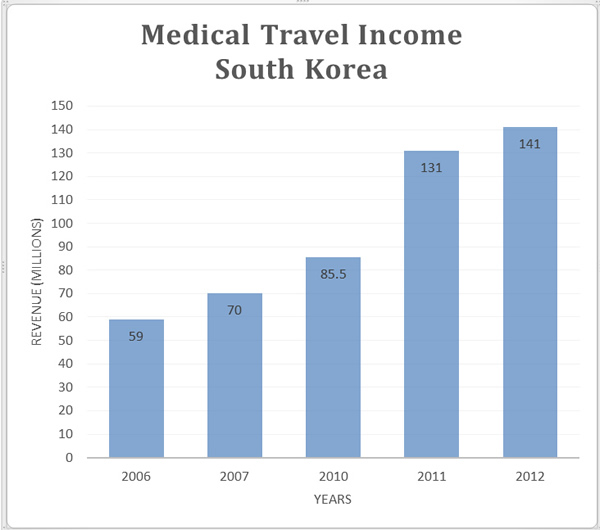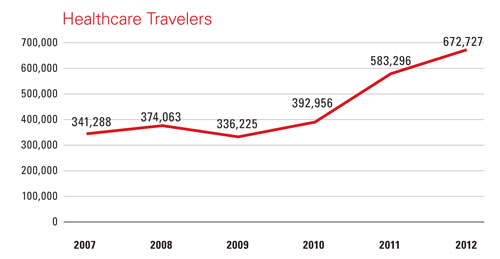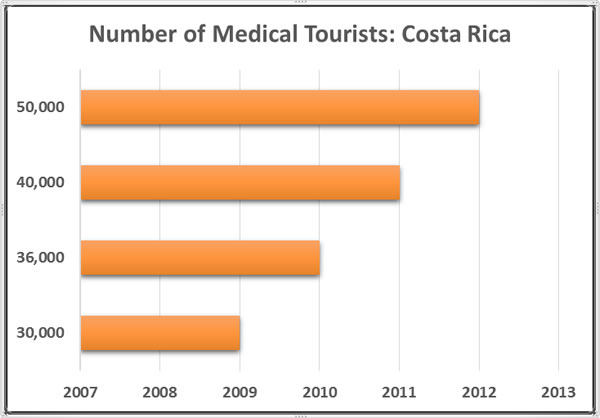Hair plugs and some Izmir resort time in Turkey. Joint replacement and a nice hotel suite in the vibrant heart of Kuala Lumpur. Dental care in Hungary. The entire sub-industry of cosmetic double-eyelid surgery (blepharoplasty) in South Korea.
With the World Medical Tourism and Global Healthcare Congress taking place next week in Orlando, Fla., it’s a good time to glance at medical tourism snapshots from around the world. Some come amid the torrent of pre-conference releases from the conference’s prime mover, the Medical Tourism Association (MTA), which in July announced it would partner with Beijing Great-Idea Business Resources Company Ltd. to stage an Asia-Pacific edition of the conference each year in China, beginning this November in Guilin.
“China is positioned to be one of the largest outbound medical tourism markets in the world, with rising income and a growing demand for the best medical treatments possible, coupled with the launch of health insurance for Chinese citizens that include travel benefits,” said Renée-Marie Stephano, president of the MTA.
“China’s healthcare reform policies and shifting economic and demographic trends are creating new opportunities for international companies seeking to invest or partner with local firms in areas, such as hospital development, senior care, biotech and pharma,” said Michael Zeng, CEO of Beijing Great-Idea Business Resources Company Ltd.
Another aggressive push is being made by the Puerto Rico Medical Tourism Corporation, an arm of the commonwealth’s tourism structure, to market the island’s healthcare services to international patients, in hopes of creating some 3,000 jobs and injecting $300 million into the island’s economy when it desperately needs it. In addition to special tax incentives, the Puerto Rico delegation is promoting medical and dental services at a cost of 40 percent to 60 percent lower than offered in the continental US, while also being able to offer medical travelers the reassurance that, because Puerto Rico is part of the United States, it is bound by the federal and state legal systems.
Magically Real
Some snapshots come from corners of the world Site Selection has visited in recent months.
With the opening of Cayman Health City, led by the vision of Dr. Devi Shetty, Cayman Islands soon may be as well known for its medical procedures as its financial ones. In an interview, the Hon. Wayne Panton, Minister of Financial Services, Commerce and Environment for the Cayman Islands Government, says health services and health tourism represent “an area with significant potential,” and not just because of foreigners.
“It represents diversification of the economy, but it also represents a vast improvement in access for the local population to high-level health services as well,” he says. “In the past, if you needed access to cardiac care, or a catheterization lab, you had to get on a plane and fly for an hour. Now we have one here, because what was previously uneconomic is subsidized by people coming in.”
A multi-year runway extension and airport terminal expansion at the airport on Grand Cayman will welcome even more tourists from even more spots on the globe, says the minister.
In Colombia, according to Migration Colombia, MinCIT and ProColombia, the number of overall inbound tourists has continued to climb, from nearly 3.5 million in 2012 to nearly 4.2 million in 2014, helped in part by a campaign — designed around the literary specialty of the late Colombian author Gabriel Garcia Marquez — inviting people to come experience the country’s “magical realism.” Looked at from the right angle, that phrase could easily stretch to accommodate medical tourism.
Looked at from a cost/benefit ratio perspective, says Juan Carlos Jimenez, investment promotion manager for Invest in Bogota, “It’s cheaper to visit and stay two or three weeks, than to get a procedure done in the US. There is a lot going into Costa Rica these days too. Much is cosmetic surgery, usually not supported by HMOs. But you’d be surprised by the difference in price.”
He notes the national clinic for healthcare and cosmetic surgeries in Bucaramanga, the capital city of Santander. Meanwhile, international relations teams at clinics are busy booking fertility treatments and eye surgeries. Some might not know, says Jimenez, that the initial method for radial keratotomy eye surgery (Lasik) was invented by Dr. José Barraquer in Bogota in the 1960s, and the country is known as well for its cardiovascular surgery and interventions.
In Barranquilla, Ana Maria Badel Gomez, executive director of ProBarranquilla, says five hotels and two hospitals under construction, in addition to the area’s first free trade zone, are all encouraging for health tourism, as the Colombian city gets ready to hose the Central American and Caribbean Games in 2018. And in the mountain-ringed metropolis of Medellin, according to the Medellin Healthcare Cluster, 24 percent of the medical and healthcare travelers that visit the Medellin Health City are from the United States.
Medical tourism is just one of several contributing factors to the country’s continuing influx of visitors. And as any economic developer will tell you, visits today sometimes translate into companies and jobs tomorrow.
“Fifteen or 20 years ago, the only foreigners you’d see would be CIA operatives,” jokes Jimenez in Bogota. “We had 500 companies in 2002 with foreign capital. There are about 1,500 today.”
‘Taking the Waters’
According to the Medical Tourism Facts and Figures 2015 report issued earlier this year by the International Medical Travel Journal, 6 million people a year travel for medical treatment from one country to another, and if you add in those who travel a distance within a country, the number exceeds 10 million.
Other sources peg the number quite a bit higher. In 2013, around 900,000 Americans traveled overseas for treatment, according to Patients Beyond Borders, which projected 1.2 million would do so in 2014. In 2012, 400,000 Americans went outside the US for dental care alone.
A 2013 MTA Medical Tourism Patient Survey found that nearly 27 percent of patients had previously traveled to a foreign country to receive medical care, most were female, all were between ages 45 and 64; the majority were White/Caucasian; all were American; all were college educated; half had household incomes between $50,000 and $100,000; and some had health insurance (50 percent), while other did not.
The survey found that nearly 80% of the demand for medical travel is driven by cost savings, but at the same time the tourist patients spend between $7,475 and $15,833 per medical travel trip.
An OECD report points out that the consumption of health care in a foreign land is not a new phenomenon. “Individuals have travelled abroad for health benefits since ancient times, and during the 19th Century in Europe, for example, there was a fashion for the growing middle-classes to travel to spa towns to ‘take the waters,’ which were believed to have health-enhancing qualities. During the 20th Century, wealthy people from less developed areas of the world travelled to developed nations to access better facilities and highly trained medics.”
That has exactly reversed itself, with tourists from allegedly developed nations traveling to less developed nations, and with the emergence of what is essentially an international market for patients.
“Many countries see significant economic development potential in the emergent field of medical tourism,” says the OECD report. “The Thai, Indian, Singaporean, Malaysian, Hungarian, Polish and Maltese governments have all sought to promote their comparative advantage as medical tourism destinations at large international trade fairs, via advertising within the overseas press, and official support for activities as part of their economic development and tourism policy.” Not to mention Dubai, Japan and South Korea.
Fasten your seatbelts and put your tray tables up, as we embark on a quick journey among the world’s medical tourism destinations, courtesy of data from the MTA.
Asia
The number of medical tourists traveling to Asia was expected to surpass 10 million by this year, with Thailand, India and Singapore expected to control more than 80 percent market share.
Korea
According to the Ministry of Health and Welfare, 210,000 non-Korean patients from 191 nations received medical treatment in Korea in 2013, an increase of 32.5 percent from the 159,464 in 2012, and a 3.5-fold increase over 2009′s figures. Chinese, American and Russian patients led the way, but the fastest-growing world region for patient exports to Korea is the Middle East.

While eyelid, jaw and nose procedures are the most common internally in Korea — a recent study by the International Society of Aesthetic Plastic Surgery estimated that South Korea had the highest rate of cosmetic surgery per capita of any country in the world — the type of treatments most commonly sought by medical travelers to Korea are internal medicine procedures, including problems with the digestion and circulatory systems.
The South Korean government is setting aside as much as $4 million a year to help promote the medical tourism industry, which is dominated by plastic surgeons. It expects 1 million medical tourists a year by 2020. South Korea’s medical travel income rose from $59 million in 2006 to $149 million in 2012.
Malaysia
The medical tourism industry in Malaysia generated approximately $20 million USD in revenue in 2013, with the number of medical tourists having risen to 768,000 from 583,000 two years earlier. As reported two years ago by Site Selection, while Malaysia positions itself to increase its exports of medical devices, medical tourism may do its part to keep those devices in-country until they’re used. According to the Malaysia Healthcare Travel Council (MHTC), an agency under Malaysia’s Ministry of Health, heart bypass surgery in Malaysia can cost as much as 90 percent less than in the United States.
Malaysia ranked 2nd in the “2013 Health Care Survey: The Best Havens for Quality Care Overseas” by International Living. And Prince Court Medical Center (Malaysia) was named No. 1 among the World’s Best Hospitals for Medical Tourists 2013 by Medical Travel Quality Alliance. Former MIDA CEO Y. Bhg. Datuk Noharuddin Nordin told Site Selection that Malaysia is poised for the widely observed convergence of the healthcare and life sciences sectors.
“Both clusters need each other,” he said. “Malaysia is positioning itself as a hub for the healthcare industry. That lends itself well to supporting the development of the medical devices industry as well. In the early days, medical tourism was the only objective. And there’s another major activity that’s taking place — the rapid growth of clinical trials in Malaysia, which take advantage of medical institutions as well as universities.”

Singapore
Singapore medical tourist arrivals were expected to total more than 1 million by this year, and keep growing at a rate nearly as healthy as its population. Singapore was ranked second out of 48 countries in Bloomberg’s 2013 ranking of healthcare systems.
Costa Rica
Costa Rica aimed to surpass 100,000 medical tourists in 2014, up from 50,000 in 2012, when they spent an average of $7,000, according to the Council for International Promotion of Costa Rica Medicine (PROMED). Close to half of these medical travelers were said to be dental, followed by orthopedics, weight loss surgeries, gynecology and plastic surgery. Medical tourism generated some $338 million in revenue for the country that year, PROMED reported.

Germany
You don’t have to have a sunny climate if your economic and health systems’ outlook are sunny enough already. Health and wellness tourism constant value sales in Germany were projected to reach €4.6 billion by 2017 – almost €120 million higher than in 2012. Medical tourism earns German hospitals and doctors roughly €1 billion ($1.35 billion) in annual revenues. Russians make up the largest group of non-European Union patients in Germany, with about 6,000 receiving inpatient treatment each year.
Dubai
According to Alpen Capital Investment Banking, UAE’s medical tourism sector reached $1.69 billion in 2013. Dubai Healthcare City (DHCC) is one of the largest healthcare tourist destinations in the region. According to DHCC, they handled around 500,000 patients in 2011, 20 percent of whom were medical tourists. Healthcare spending in the UAE was expected to reach US$11 billion by this year.
The Dubai Health Authority hopes to attract 500,000 medical tourism patients a year and plans to build 22 hospitals, boosting the national economy by up to US$700 million by 2020, when the UAE will host the World Expo.
Turkey
According to data from the Turkish Statistical Institute (TurkStat), the number of visitors that came to the country for medical reasons reached an all-time high of 414,600 in 2014, up 55 percent over the preceding year. They spent US$837 million on treatment.
As part of a plan to introduce tax-free healthcare zones specifically tailored to foreign patients, Turkey’s Ministry of Health intends to increase the number of medical tourists to 500,000 by 2015 and to 2 million by 2023. The country has doubled its healthcare spending in the last 10 years, reaching $62.3 billion, to serve its large population of 74.7 million and an increasing patient base.

